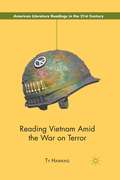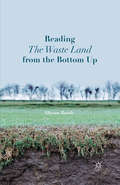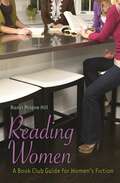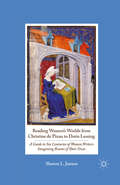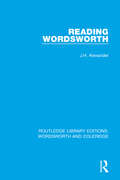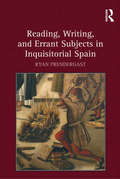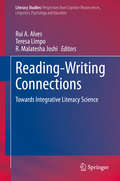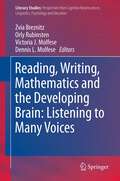- Table View
- List View
Reading Vietnam Amid the War on Terror (American Literature Readings in the 21st Century)
by T. HawkinsArgues that the examination of contemporary American war narratives can lead to newfound understandings of American literature, American history, and American national purpose. To prove such a contention, the book blends literary, rhetorical, and cultural methods of analysis.
Reading W.S. Merwin in a New Century: American and European Perspectives (American Literature Readings in the 21st Century)
by Cheri Colby LangdellThis edited collection explores the work of highly awarded and twice American Poet Laureate W. S. Merwin. Spanning Merwin’s early career, his mid-career success, his Hawaiian epic, his eco-poetry, his lesser-known later poetry and the influence of Buddhism on his work, the volume offers new perspectives on Merwin as a major poet. Exploring his works across the twentieth and twenty-first century, this collection presents Merwin as a necessary and contemporary poet. It emphasizes contemporary readings of Merwin as an environmental advocate, showing how his poetry seeks to help each reader re-establish an intimate relationship with the natural world. It also highlights how Merwin’s work presents our place in history as a pivotal moment of transition into a new era of international cooperation. This volume both celebrates his life and writing and takes scholarship on his work forward into the new century.
Reading Walter de la Mare
by Walter de la MareWalter de la Mare (1873-1956) was one of the best-loved English poets of the twentieth century, his verse admired by contemporaries including Thomas Hardy, Robert Frost, W. H. Auden and T. S. Eliot. This volume presents a new selection of de la Mare's finest poems, including perennial favourites such as 'Napoleon', 'Fare Well' and 'The Listeners', for a twenty-first-century audience. The poems are accompanied by commentaries by William Wootten, which build up a portrait of de la Mare's life, loves and friendships with the likes of Hardy, Rupert Brooke, Edward Thomas and Katherine Mansfield. They also point out the fascinating references to literature, folklore and the natural world that embroider the verse.
Reading The Waste Land from the Bottom Up
by A. BoothA guidebook to the allusions of T.S. Eliot's notorious poem, The Waste Land , Reading The Waste Land from the Bottom Up utilizes the footnotes as a starting point, opening up the poem in unexpected ways. Organized according to Eliot's line numbers and designed for both scholars and students, chapters are free-standing and can be read in any order.
Reading William Blake
by S. BehrendtWilliam Blake's illuminated poems challenge their readers to participate fully in a highly interactive process of reading. The complex interaction of their verbal and visual texts forces the involved reader to assume greater responsibility than usual for formulating meaning. This book examines some of the ways in which Blake's illuminated poems subvert the customary authority of texts and force readers to reassess both their expectations about reading and their customary responses to words and visual images alike.
Reading Women: A Book Club Guide for Women's Fiction
by Nanci Milone HillAn indispensable guide for anyone who runs or participates in a book group, this title provides the structure and fun facts needed to examine the genre of women's fiction.Women's fiction covers numerous topics of importance in the lives of women—friendship, love, personal growth, and familial relationships. For this reason, the genre is a hotbed of engaging subjects for book group discussions. Reading Women: A Book Club Guide for Women's Fiction brings together information on over 100 women's fiction titles, providing everything a book group needs to encourage focused, stimulating meetings.Reading Women marshals information that has been, up to this point, either nonexistent or scattered in book club guides. Readers will learn the difference between women's fiction, romance, and chick lit, as well as why these genres provide a rich trove of discussion topics for book groups. Specific entries cover titles from all three genres, offering an author biography, a book summary, bibliographic material, discussion questions, and read-alike information for each book. An additional 50 titles suitable for book group discussions are listed with brief summaries.
Reading Women: A Book Club Guide for Women's Fiction
by Nanci Milone HillAn indispensable guide for anyone who runs or participates in a book group, this title provides the structure and fun facts needed to examine the genre of women's fiction.Women's fiction covers numerous topics of importance in the lives of women—friendship, love, personal growth, and familial relationships. For this reason, the genre is a hotbed of engaging subjects for book group discussions. Reading Women: A Book Club Guide for Women's Fiction brings together information on over 100 women's fiction titles, providing everything a book group needs to encourage focused, stimulating meetings.Reading Women marshals information that has been, up to this point, either nonexistent or scattered in book club guides. Readers will learn the difference between women's fiction, romance, and chick lit, as well as why these genres provide a rich trove of discussion topics for book groups. Specific entries cover titles from all three genres, offering an author biography, a book summary, bibliographic material, discussion questions, and read-alike information for each book. An additional 50 titles suitable for book group discussions are listed with brief summaries.
Reading Women in Late Medieval Europe: Anne of Bohemia and Chaucer’s Female Audience (The New Middle Ages)
by Alfred ThomasAlthough Chaucer is typically labeled as the "Father of English Literature," evidence shows that his work appealed to Europe and specifically European women. Rereading the Canterbury Tales , Thomas argues that Chaucer imagined Anne of Bohemia, wife of famed Richard II, as an ideal reader, an aspect that came to greatly affect his writing.
Reading Women's Worlds from Christine de Pizan to Doris Lessing: A Guide to Six Centuries of Women Writers Imagining Rooms of Their Own
by S. JansenIn this work, Jansen explores a recurring theme in writing by women: the dream of finding or creating a private and secluded retreat from the world of men. These imagined "women's worlds" may be very small, a single room, for example, but many women writers are much more ambitious, fantasizing about cities, even entire countries, created for and inhabited exclusively by women.
Reading Words into Worlds: Phenomenological Mimesis of Givenness in the Novel (Literary Criticism and Cultural Theory)
by J. Clayton McReynoldsReading Words into Worlds asks how it is that reading a novel can feel in some ways like being-in-a-world. The book explores how novels give themselves to readers in ways that mimetically resemble our phenomenological reception of given beings in reality. McReynolds refers to this process as phenomenological mimesis of givenness, and he draws on the phenomenological philosophy of Husserl, Heidegger, and Jean-Luc Marion to explore how masterful novels can make reading ink marks on a page feel like seeing things, feeling things, and meeting (even loving) others. McReynolds blends rigorous phenomenological study with a personable style, first laying out his theory in detail and then applying that theory through close studies of his reading experiences of four British realist masterpieces: Defoe’s Robinson Crusoe, Austen’s Northanger Abbey, Eliot’s Middlemarch, and Hardy’s Jude the Obscure. Ultimately, this book offers a grounded phenomenology of novel-reading, illuminating what gives novels such power to not only thrill readers—but to change them.
Reading Words into Worlds: Phenomenological Mimesis of Givenness in the Novel (Literary Criticism and Cultural Theory)
by J. Clayton McReynoldsReading Words into Worlds asks how it is that reading a novel can feel in some ways like being-in-a-world. The book explores how novels give themselves to readers in ways that mimetically resemble our phenomenological reception of given beings in reality. McReynolds refers to this process as phenomenological mimesis of givenness, and he draws on the phenomenological philosophy of Husserl, Heidegger, and Jean-Luc Marion to explore how masterful novels can make reading ink marks on a page feel like seeing things, feeling things, and meeting (even loving) others. McReynolds blends rigorous phenomenological study with a personable style, first laying out his theory in detail and then applying that theory through close studies of his reading experiences of four British realist masterpieces: Defoe’s Robinson Crusoe, Austen’s Northanger Abbey, Eliot’s Middlemarch, and Hardy’s Jude the Obscure. Ultimately, this book offers a grounded phenomenology of novel-reading, illuminating what gives novels such power to not only thrill readers—but to change them.
Reading Wordsworth (RLE: Wordsworth and Coleridge)
by J.H. AlexanderFirst published in 1987, this book is written for those who are encountering Wordsworth for the first time and for those familiar with his works that are at a loss to understand his reputation or why his work has impressed them. The strength of the author’s approach is that it unravels the poet’s true meaning and the process by which he all too frequently lost the voice of inspiration — working and reshaping his poems until the original freshness disappeared. It concentrates on helping the reader appreciate Wordsworth’s distinctive and daring way with words and poetic structure. By showing Wordsworth’s failures, the author demonstrates by contrast the achievements of his greatest works.
Reading Wordsworth (RLE: Wordsworth and Coleridge)
by J.H. AlexanderFirst published in 1987, this book is written for those who are encountering Wordsworth for the first time and for those familiar with his works that are at a loss to understand his reputation or why his work has impressed them. The strength of the author’s approach is that it unravels the poet’s true meaning and the process by which he all too frequently lost the voice of inspiration — working and reshaping his poems until the original freshness disappeared. It concentrates on helping the reader appreciate Wordsworth’s distinctive and daring way with words and poetic structure. By showing Wordsworth’s failures, the author demonstrates by contrast the achievements of his greatest works.
Reading Work: Literacies in the New Workplace
by Mary Ellen Belfiore Tracy A. Defoe Sue Folinsbee Judy Hunter Nancy S. JacksonReading Work: Literacies in the New Workplace explores changing understandings of literacy and its place in contemporary workplace settings. It points to new questions and dilemmas to consider in planning and teaching workplace education. By taking a social perspective on literacies in the workplace, this book challenges traditional thinking about workplace literacy as functional skills, and enables readers to see the complexity of literacy practices and their embeddedness in culture, knowledge, and action. A mixture of ethnographic studies, analysis, and personal reflections makes these ideas accessible and relevant to a wide range of readers in the fields of adult literacy and language education and helps to bridge the divide between theory and practice in the field of workplace education.Reading Work: Literacies in the New Workplace features: *four distinct but related ethnographies of literacy use in contemporary workplaces;*a social practice view of literacy brought to the workplace;*collaborative research undertaken by experienced workplace educators and academics working in the areas of adult literacy and second language learning;*implications chapters for both practice and theory--presented not as a series of steps but rather as reflections by seasoned educators on shared dilemmas; and*engaging, accessible writing that encourages workplace practitioners to read, learn from, and do their own research.This book is an important resource for practicing workplace educators, trainers, and instructors; academics who teach workplace educators; unionists, policymakers, human resource managers, supervisors, or quality coordinators who believe education can make a difference and are interested in seeing maximum results from workplace learning. Visit the In-Sites Research Group Web site: http://www.nald.ca/insites/.
Reading Work: Literacies in the New Workplace
by Mary Ellen Belfiore Tracy A. Defoe Sue Folinsbee Judy Hunter Nancy S. JacksonReading Work: Literacies in the New Workplace explores changing understandings of literacy and its place in contemporary workplace settings. It points to new questions and dilemmas to consider in planning and teaching workplace education. By taking a social perspective on literacies in the workplace, this book challenges traditional thinking about workplace literacy as functional skills, and enables readers to see the complexity of literacy practices and their embeddedness in culture, knowledge, and action. A mixture of ethnographic studies, analysis, and personal reflections makes these ideas accessible and relevant to a wide range of readers in the fields of adult literacy and language education and helps to bridge the divide between theory and practice in the field of workplace education.Reading Work: Literacies in the New Workplace features: *four distinct but related ethnographies of literacy use in contemporary workplaces;*a social practice view of literacy brought to the workplace;*collaborative research undertaken by experienced workplace educators and academics working in the areas of adult literacy and second language learning;*implications chapters for both practice and theory--presented not as a series of steps but rather as reflections by seasoned educators on shared dilemmas; and*engaging, accessible writing that encourages workplace practitioners to read, learn from, and do their own research.This book is an important resource for practicing workplace educators, trainers, and instructors; academics who teach workplace educators; unionists, policymakers, human resource managers, supervisors, or quality coordinators who believe education can make a difference and are interested in seeing maximum results from workplace learning. Visit the In-Sites Research Group Web site: http://www.nald.ca/insites/.
Reading, Writing and Arithmetic: Mastering the Three Rs of an Old-Fashioned Education
by Daniel SmithMost of us suffer from the odd gap in our knowledge. But what if those gaps happen to be gaping chasms that threaten to cave in if not soon filled? Worry not, for the answer is at hand. Reading, Writing and Arithmetic harks back to a golden age of teaching, providing a comprehensive introduction to the three Rs: the basics of reading, writing and arithmetic. With everything from reading efficiently and mastering grammar, to grasping paper and mental arithmetic, this comprehensive tome rallies through the gamut of fascinating content, including: Grammar tests; How to write and form letters properly; Exercises for mastering fractions, decimals and rounding to the nearest; Tips for tackling everyday maths conundrums, such as adding bills and working out percentages and much more besides!In a fitting tribute to the education system of yesteryear, this nostalgic book provides a solid foundation in the key areas of learning that will mean everything else just falls into place.
Reading, Writing, and Errant Subjects in Inquisitorial Spain
by Ryan PrendergastReading, Writing, and Errant Subjects in Inquisitorial Spain explores the conception and production of early modern Spanish literary texts in the context of the inquisitorial socio-cultural environment of the sixteenth and seventeenth centuries. Author Ryan Prendergast analyzes instances of how the elaborate censorial system and the threat of punishment that both the Inquisition and the Crown deployed did not deter all writers from incorporating, confronting, and critiquing legally sanctioned practices and the exercise of institutional power designed to induce conformity and maintain orthodoxy. The book maps out how texts from different literary genres scrutinize varying facets of inquisitorial discourse and represent the influence of the Inquisition on early modern Spanish subjects, including authors and readers. Because of its incorporation of inquisitorial scenes and practices as well as its integration of numerous literary genres, Don Quixote serves as the book's principal literary resource. The author also examines the Moorish novel/ la novela morisca with special attention to the question of the religious and cultural Others, in particular the Muslim subject; the Picaresque novel/la novela picaresca, focusing on the issues of confession and punishment; and theatrical representations and dramatic texts, which deal with the public performance of ideology. The texts, which had differing levels of contact with censorial processes ranging from complete prohibition to no censorship, incorporate the issues of control, intolerance, and resistance. Through his close readings of Golden Age texts, Prendergast investigates the strategies that literary characters, many of them represented as legally or socially errant subjects, utilize to negotiate the limits that authorities and society attempt to impose on them, and demonstrates the pervasive nature of the inquisitorial specter in sixteenth- and seventeenth-century Spanish cultural production.
Reading, Writing, and Errant Subjects in Inquisitorial Spain
by Ryan PrendergastReading, Writing, and Errant Subjects in Inquisitorial Spain explores the conception and production of early modern Spanish literary texts in the context of the inquisitorial socio-cultural environment of the sixteenth and seventeenth centuries. Author Ryan Prendergast analyzes instances of how the elaborate censorial system and the threat of punishment that both the Inquisition and the Crown deployed did not deter all writers from incorporating, confronting, and critiquing legally sanctioned practices and the exercise of institutional power designed to induce conformity and maintain orthodoxy. The book maps out how texts from different literary genres scrutinize varying facets of inquisitorial discourse and represent the influence of the Inquisition on early modern Spanish subjects, including authors and readers. Because of its incorporation of inquisitorial scenes and practices as well as its integration of numerous literary genres, Don Quixote serves as the book's principal literary resource. The author also examines the Moorish novel/ la novela morisca with special attention to the question of the religious and cultural Others, in particular the Muslim subject; the Picaresque novel/la novela picaresca, focusing on the issues of confession and punishment; and theatrical representations and dramatic texts, which deal with the public performance of ideology. The texts, which had differing levels of contact with censorial processes ranging from complete prohibition to no censorship, incorporate the issues of control, intolerance, and resistance. Through his close readings of Golden Age texts, Prendergast investigates the strategies that literary characters, many of them represented as legally or socially errant subjects, utilize to negotiate the limits that authorities and society attempt to impose on them, and demonstrates the pervasive nature of the inquisitorial specter in sixteenth- and seventeenth-century Spanish cultural production.
Reading, Writing, and Talking Gender in Literacy Learning (IRA's Literacy Studies Series)
by Barbara J. Guzzetti Josephine Peyto Young Margaret M. Gritsavage Laurie M. Fyfe Marie HardenbrookUntil now, there has been no systematic analysis or review of the research on gender and literacy. With all the media attention and research surveys surrounding gender bias and the inequities that continue to flourish in education, a synthesis of the research studies was needed to raise awareness of gender issues in learning and literacy, to provide successful interventions and recommendations to educators, and to point out the direction for future inquiries by examining the unanswered questions of the existing research. For the convenience of readers, the studies are organized by genre: gender and discussion, reading, writing, electronic text, and literacy autobiography. Published by International Reading Association
Reading, Writing, and Talking Gender in Literacy Learning (IRA's Literacy Studies Series)
by Barbara J. Guzzetti Josephine Peyto Young Margaret M. Gritsavage Laurie M. Fyfe Marie HardenbrookUntil now, there has been no systematic analysis or review of the research on gender and literacy. With all the media attention and research surveys surrounding gender bias and the inequities that continue to flourish in education, a synthesis of the research studies was needed to raise awareness of gender issues in learning and literacy, to provide successful interventions and recommendations to educators, and to point out the direction for future inquiries by examining the unanswered questions of the existing research. For the convenience of readers, the studies are organized by genre: gender and discussion, reading, writing, electronic text, and literacy autobiography. Published by International Reading Association
Reading, writing and the influence of Harold Bloom
by Jonathon Shears Alan RawesReading, writing and the influence of Harold Bloom takes the work of the world’s best-known living literary critic and discovers what it is like to read ‘with’, ‘against’ and ‘beyond’ his ideas. The editors, Alan Rawes and Jonathon Shears, introduce the collection by assessing the impact of Bloom’s brand of agonistic criticism on literary critics and its ongoing relevance to a discipline attempting to redefine and settle on its collective goals. Firmly grounded in, though not confined to, Bloom’s first specialism of Romantic Studies, the volume contains essays that examine Bloom’s debts to high Romanticism, his quarrels with feminism, his resistance to historicism, the tensions with the ‘Yale School’ and his recent work on Shakespeare and genius. Crucially, chapters are also devoted to putting Bloom’s anxiety-themed ratios into practice on the poetry of Wordsworth, Shelley, Keats and D. H. Lawrence, amongst others. The Harold Bloom that emerges from this collection is by turns divisive and unifying, marginalised and central, radical and conservative.
Reading-Writing Connections: From Theory to Practice
by Mary F. HellerReading-Writing Connections: From Theory to Practice is an extraordinary language arts methods text that enables elementary and middle school teachers to create classroom environments where all students can become lifelong readers and writers. Focusing on developmentally appropriate methods and materials, this remarkably readable book empowers a new generation of teachers to integrate reading, writing, listening, and speaking in K-8 classrooms. Heller's highly accessible writing style makes this book suitable as a primary text for undergraduate and graduate courses in language arts, reading, writing, and literacy. Special features of this second edition include: * a vision of how to transform cutting-edge theory and research into classroom practice that utilizes integrated language arts instruction; *a unique developmental perspective with separate chapters on teaching methods and materials for kindergarten, primary (1-3), intermediate (4-6), and middle grades (7-8); * instructional guidelines that offer generous, detailed suggestions for applying theory to practice, plus "For You to Try" and "For Your Journal" exercises that encourage critical thinking and reflection; and * a wealth of classroom vignettes, examples of students' oral and written language, illustrations, and figures that accentuate interesting and informative theory, research, and practice. In addition, Reading-Writing Connections offers expanded content on the impact of sociocultural theory and the whole language movement on the teaching of reading and writing across the curriculum; greater emphasis on cultural diversity, including new multicultural children's literature booklists that complement the general children's literature bibliographies; and current information on alternative assessment, emerging technologies, the multiage classroom, reader response to literature, and thematic teaching.
Reading-Writing Connections: From Theory to Practice
by Mary F. HellerReading-Writing Connections: From Theory to Practice is an extraordinary language arts methods text that enables elementary and middle school teachers to create classroom environments where all students can become lifelong readers and writers. Focusing on developmentally appropriate methods and materials, this remarkably readable book empowers a new generation of teachers to integrate reading, writing, listening, and speaking in K-8 classrooms. Heller's highly accessible writing style makes this book suitable as a primary text for undergraduate and graduate courses in language arts, reading, writing, and literacy. Special features of this second edition include: * a vision of how to transform cutting-edge theory and research into classroom practice that utilizes integrated language arts instruction; *a unique developmental perspective with separate chapters on teaching methods and materials for kindergarten, primary (1-3), intermediate (4-6), and middle grades (7-8); * instructional guidelines that offer generous, detailed suggestions for applying theory to practice, plus "For You to Try" and "For Your Journal" exercises that encourage critical thinking and reflection; and * a wealth of classroom vignettes, examples of students' oral and written language, illustrations, and figures that accentuate interesting and informative theory, research, and practice. In addition, Reading-Writing Connections offers expanded content on the impact of sociocultural theory and the whole language movement on the teaching of reading and writing across the curriculum; greater emphasis on cultural diversity, including new multicultural children's literature booklists that complement the general children's literature bibliographies; and current information on alternative assessment, emerging technologies, the multiage classroom, reader response to literature, and thematic teaching.
Reading-Writing Connections: Towards Integrative Literacy Science (Literacy Studies #19)
by R. Malatesha Joshi Rui A. Alves Teresa LimpoThis book shows that reading-writing is a two-way street that is burgeoning with research activity. It provides a comprehensive and updated view on reading-writing connections by drawing on extant research and findings. It puts forward a new conception of literacy, one that establishes reading and writing connections as the primeval ground for building literacy science. It shows how an integrative view of literacy can have deep and lasting effects on conceptualizing literacy development in several orthographies and on improving literacy instruction and remediation worldwide. The book examines in detail such issues as modeling approaches to reading-writing relations, literacy development, reading and spelling across orthographies and integrative approaches to literacy instruction and remediation.
Reading, Writing, Mathematics and the Developing Brain: Listening to Many Voices (Literacy Studies #6)
by Zvia Breznitz, Orly Rubinsten, Victoria J. Molfese and Dennis L. MolfeseThis valuable addition to the literature offers readers a comprehensive overview of recent brain imaging research focused on reading, writing and mathematics—a research arena characterized by rapid advances that follow on the heels of fresh developments and techniques in brain imaging itself. With contributions from many of the lead scientists in this field, a number of whom have been responsible for key breakthroughs, the coverage deals with the commonalities of, as well as the differences between, brain activity related to the three core educational topics. At the same time, the volume addresses vital new information on both brain and behavior indicators of developmental problems, and points out the new directions being pursued using current advances in brain imaging technologies as well as research-based interventions. The book is also a tribute to a new Edmund, J Safra Brain center for the study of learning Disabilities at the University of Haifa-Israel.
